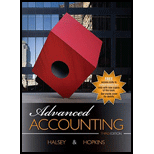
Differentiate between non-profit organizations and typical business enterprises.
Explanation of Solution
Non-profit organizations are privately held corporations that do not provide financial benefits to their members or creditors and are formed for public or mutual benefit other than to generate profits for shareholders or investors whereas a business enterprise is a for-profit entity associated with the production, selling or distribution of goods or services. A business enterprise may be organized as a sole proprietorship, a
Non-profit organizations are fundamentally different from business enterprises.
They receive a significant portion of their income in the form of donations from individuals who do not request a monetary payment in return (i.e. non-exchange transactions), their business purpose is to provide a social benefit, not solely to provide goods or services for profit, and they do not have the right to do so.
Want to see more full solutions like this?
Chapter 11 Solutions
ADVANCED ACCOUNTING
- Can you solve this general accounting problem with appropriate steps and explanations?arrow_forwardDuring 2018, Jacob Industries had sales on account of $945,000, cash sales of $372,000, and collections on account of $782,000. As a result of these transactions, the change in the accounts receivable indicates an increase of how much?arrow_forwardWhich accounting principle requires that expenses be recorded in the same period as the revenues they help generate?A. Cost PrincipleB. Revenue Recognition PrincipleC. Matching PrincipleD. Full Disclosure Principlesolve it.arrow_forward
- In pension accounting, actuarial gains and losses are____. a) Recognized in other comprehensive income b) Always recognized immediately in profit or loss c) Deferred indefinitely d) Added to pension obligation directlyarrow_forwardDC Co. exchanged equipment and $25,000 cash for similar equipment. The book value and fair value of the old equipment were $120,000 and $135,000, respectively. Assuming that the exchange has commercial substance, DC would record a gain/(loss) of __.arrow_forwardPlease show me the valid approach to solving this financial accounting problem with correct methods.arrow_forward
- Help with accounting questionarrow_forwardWhich accounting principle requires that expenses be recorded in the same period as the revenues they help generate?A. Cost PrincipleB. Revenue Recognition PrincipleC. Matching PrincipleD. Full Disclosure Principlearrow_forwardI need guidance with this financial accounting problem using the right financial principles.arrow_forward
- What is the formula for calculating the weighted average cost of capital (WACC)?A) WACC = (Cost of Debt × Proportion of Debt) + (Cost of Equity × Proportion of Equity)B) WACC = (Cost of Debt + Cost of Equity) / 2C) WACC = Cost of Debt + Cost of EquityD) WACC = Proportion of Debt + Proportion of Equityarrow_forwardIf a company has annual sales of $840,000 with a gross profit margin of 35%, what is the cost of goods sold?arrow_forwardKindly help me with general accounting questionarrow_forward

 AccountingAccountingISBN:9781337272094Author:WARREN, Carl S., Reeve, James M., Duchac, Jonathan E.Publisher:Cengage Learning,
AccountingAccountingISBN:9781337272094Author:WARREN, Carl S., Reeve, James M., Duchac, Jonathan E.Publisher:Cengage Learning, Accounting Information SystemsAccountingISBN:9781337619202Author:Hall, James A.Publisher:Cengage Learning,
Accounting Information SystemsAccountingISBN:9781337619202Author:Hall, James A.Publisher:Cengage Learning, Horngren's Cost Accounting: A Managerial Emphasis...AccountingISBN:9780134475585Author:Srikant M. Datar, Madhav V. RajanPublisher:PEARSON
Horngren's Cost Accounting: A Managerial Emphasis...AccountingISBN:9780134475585Author:Srikant M. Datar, Madhav V. RajanPublisher:PEARSON Intermediate AccountingAccountingISBN:9781259722660Author:J. David Spiceland, Mark W. Nelson, Wayne M ThomasPublisher:McGraw-Hill Education
Intermediate AccountingAccountingISBN:9781259722660Author:J. David Spiceland, Mark W. Nelson, Wayne M ThomasPublisher:McGraw-Hill Education Financial and Managerial AccountingAccountingISBN:9781259726705Author:John J Wild, Ken W. Shaw, Barbara Chiappetta Fundamental Accounting PrinciplesPublisher:McGraw-Hill Education
Financial and Managerial AccountingAccountingISBN:9781259726705Author:John J Wild, Ken W. Shaw, Barbara Chiappetta Fundamental Accounting PrinciplesPublisher:McGraw-Hill Education





